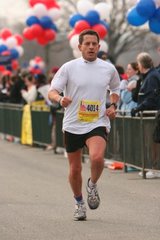Deaths Draw Attention to Triathlon Swim

Participants of the Indonesian Triathlon in June.
WHEN 60-year-old Donald Morehouse and 52-year-old John Hobgood Jr. died in different triathlon events last weekend, they became at least the seventh and eighth triathletes to die during competition this year. Those deaths came just one week after Esteban Neira, 32, died during the New York City Triathlon.
While this does not imply an epidemic — triathlon deaths remain rare — the deaths do share a puzzling resemblance: Like all of the triathlon deaths recorded by USA Triathlon at its sanctioned events in the last two years, they happened during the swim portion of the event, which also includes biking and running.
It is always striking when an athlete dies during an endurance competition, especially a young or well-conditioned athlete presumed to be at the peak of fitness. When Ryan Shay, a 28-year-old marathon champion, collapsed and died during the Olympic marathon trials last fall, even his closest friends and family were shocked. (Tests later determined his death was brought on by an irregular heartbeat that stemmed from an enlarged and scarred heart.)
But what makes the triathlon deaths more mysterious is that they all occurred during the first part of the race. Deaths during marathons tend to be more evenly distributed over the course of the 26.2 miles, with the largest grouping in the last mile, said Dr. William Roberts, a professor of family medicine at the University of Minnesota Medical School and the medical director of the Twin Cities Marathon, who has studied marathon deaths in the United States.
An initial autopsy on Mr. Neira was inconclusive, and the New York City Medical Examiner’s office is awaiting further test results. The death of Mr. Morehouse, at the Spudman Triathlon in Burley, Idaho (an event not sanctioned by USA Triathlon), was ruled an accidental drowning after an initial autopsy, said Scott Slaymaker, the chief executive of Slaymaker Group Inc., where Mr. Morehouse was a top executive. (The family did not want to pursue further tests, Mr. Slaymaker said.) Mr. Hobgood’s death, at the New Jersey State Triathlon, was also ruled an accidental drowning after an initial autopsy, said Lt. Carl Walsh of the West Windsor Township Police Department, with further toxicology results pending.
Hundreds of thousands have taken part in triathlons over the last four years, and with just 23 deaths recorded by USA Triathlon since 2004 (not including last weekend’s deaths), the timing could be a statistical anomaly. But this much is clear: 18 of those 23 deaths occurred during the swim.
“There have been some striking similarities among recent fatalities,” said Kathy Matejka, the director of event services at USA Triathlon, which does not track the number of triathlon participants. At least seven of those who died this year, she said, were men with “some measure of experience with the sport.”
Despite these similarities, a precise cause of death remains elusive in many cases. News reports suggest that at least three of this year’s deaths were linked to heart problems, but it is unclear whether those problems were primed to happen imminently or may not have happened until later without the race as a trigger.
No one knows why deaths are more common during the swim portion of triathlons, but researchers have some intriguing theories. Public accounts of this year’s fatalities indicate that the athletes seemed outwardly healthy, and in some cases autopsies turned up no obvious cause of death, such as blocked arteries.
The combination of apparent good health and a negative autopsy suggests a death caused by abnormal heart rhythms, said Dr. Pamela Douglas, a Duke University cardiologist who has studied triathletes.
Evidence suggests that swimming may trigger a certain type of cardiac arrhythmia caused by a genetic condition called long QT syndrome, said Dr. Michael Ackerman, a cardiologist and the director of the Windland Smith Rice Sudden Death Genomics Laboratory at the Mayo Clinic in Rochester, Minn. About 1 in 2,000 people are born with a heart condition that causes a glitch in the heart’s electrical system, and the most common of these is called long QT syndrome, after the tell-tale interval on an electrocardiogram.
The long QT heart recharges sluggishly between beats, setting up the potential for a skipped beat, Dr. Ackerman said. When the problem strikes, a heart’s electrical system can go haywire, degenerating into a possibly fatal arrhythmia.
Dr. Ackerman’s research team has identified several genetic forms of long QT, and one seems especially bothered by swimming, he said. He’s not sure why, but sees clues in a Japanese study several years ago that found that irregular heartbeats occur more commonly during swimming than during the same level of aerobic activity on land.
“It’s not that swimming is horrendously dangerous and running is not,” he said.
“We know that swimming is one of those triggers,” Dr. Ackerman said, “but it’s not going to be the absolute trigger.” An expert could detect most cases of long QT syndrome on an electrocardiogram, he said.
In any type of competitive racing situation, Dr. Douglas said, the adrenaline rush at the start could aggravate conditions like long QT syndrome, because adrenaline and its related hormones can make the heart more prone to arrhythmias. Physical exertion won’t create a heart problem where none existed, she said, but it can create problems for people with underlying cardiac disease.
Sudden fainting remains the classic warning sign of an underlying arrhythmia problem. “If you faint while running a race and your heart snaps back into sync 10 or 30 seconds later, you wake up,” Dr. Ackerman said. “If it happens in the water, even if your heart regains rhythm 30 seconds later, now you’re underwater.”
Many triathletes point to the swim as a triathlon’s most stressful segment. Most swims take place in open, often cold, water with hundreds or thousands of other swimmers vying for position. “Nothing can prepare a newbie for the start,” said Russ Evenhuis, a triathlete in Olympia, Wash. “It can be like jumping into a washing machine. You will get swum over, kicked, hit and banged into.”
A triathlon’s open-water swim hardly resembles the pools where most triathletes train, said Neil Cook, a New York City based triathlete and coach. “There is no wall 25 yards away, you can’t see the bottom and the 50 to 150 people around you are more than you’ve probably swam with in total during your training,” he said. “Oh, and you are wearing this wetsuit that’s tighter than a girdle.” Raise your heart rate and blood pressure under those conditions, he said, and “any weakness you have will become apparent.”
FABIAN QUESADA, 42, of Brooklyn prepared for the New York City Triathlon by taking part in an open-water training session with the Leukemia and Lymphoma Society’s Team in Training program. Still, he had a bout of anxiety his first time in open water. “Even though the wetsuit keeps you buoyant, it’s very restrictive, and you panic because it’s tight,” he said. “It can be an overwhelming experience.”
Triathlons normally brief participants on safety procedures, some of which are standard practice. For instance, “If you’re in the water and you have a problem, you’re supposed to stop and raise your hand,” said Dr. Doug Hiller, the chief medical officer for the International Triathlon Union, the sport’s worldwide governing body.
Ms. Matejka of USA Triathlon said her organization is committed to safety and will ask its experts to look for lessons in this year’s deaths, but as of yet, the group has no major changes planned.
“Speaking as a 20-plus-year triathlete, I wouldn’t change a thing,” said Andrew Hunt, the medical director for USA Triathlon.
“Do I think open-water swimming is inherently dangerous? No I don’t,” he said. Regarding the number of swim deaths, he said last week: “You can’t just look at the numerator, you have to look at the denominator — my guess is that that number is probably in the six figures. Six out of a hundred thousand isn’t that many.”
But no one really knows what the denominator is, because USA Triathlon does not keep records of race participants. While the number of USA Triathlon members has risen from 53,254 in 2004 to 100,674 in 2007, that doesn’t account for everyone who races because nonmembers can buy a one-day license for individual events.
There’s no way to regulate away risk, Dr. Hunt said, and some triathletes say that’s part of the appeal. “We want to push the limit of our comfort zone and experience life,” said Joe Bator, 37, of Boston. “Sure we want to minimize those risks,” he said. “But when it is time to race and put on that number, we need to be willing to push just a little bit more and get just a little bit more uncomfortable. If we don’t, we will never know what we are capable of achieving.”












No comments:
Post a Comment